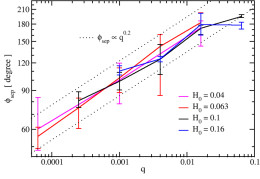Young, forming planets can generate immense spiral structures within their protoplanetary disks. A recent study has shown that observations of these spiral structures may allow astronomers to measure the mass of the planets that create them.
Spirals From Waves

Snapshots of the surface density of a protoplanetary disk in a 2D simulation, 3D simulation, and synthesized scattered-light image. Click for a closer look! [Fung & Dong, 2015]
But what do these arms look like, and what factors determine their structure? In a recently published study, Jeffrey Fung and Ruobing Dong, two researchers at the University of California at Berkeley, have modeled the spiral arms in an effort to answer these questions.
Arms Provide Answers
A useful parameter for describing the structure is the azimuthal separation (φsep) between the primary and secondary spiral arms. If you draw a circle within the disk and measure the angle between the two points where the primary and secondary arms cross it, that’s φsep.

Azimuthal separation of the primary and secondary spiral arms, as a function of the planet-to-star mass ratio q. The different curves represent different disk aspect ratios. [Fung & Dong, 2015]
If this new theory is confirmed, it could have very interesting implications for observations of protoplanetary disks: this would give us the ability to measure the mass of a planet in a disk without ever needing to directly observe the planet itself!
Modeling Observations
Fung and Dong confirm their models by additionally running 3D simulations, which yield very similar outcomes. From these simulation results, they then synthesize scattered-light images similar to what we would expect to be able to observe with telescopes like the VLT, Gemini, or Subaru. The authors demonstrate that from these scattered-light images, they can correctly retrieve the planet’s mass to within 30%.
Finally, as a proof-of-concept, the authors apply this modeling to an actual system: SAO 206462, a nearly face-on protoplanetary disk with an observed two-armed spiral within it. From the measured azimuthal separation of the two arms, the authors estimate that it contains a planet of about 6 Jupiter masses.
Citation
Jeffrey Fung (馮澤之) and Ruobing Dong (董若冰) 2015 ApJ 815 L21. doi:10.1088/2041-8205/815/2/L21
